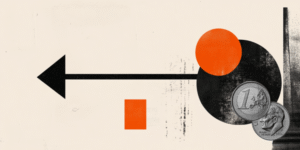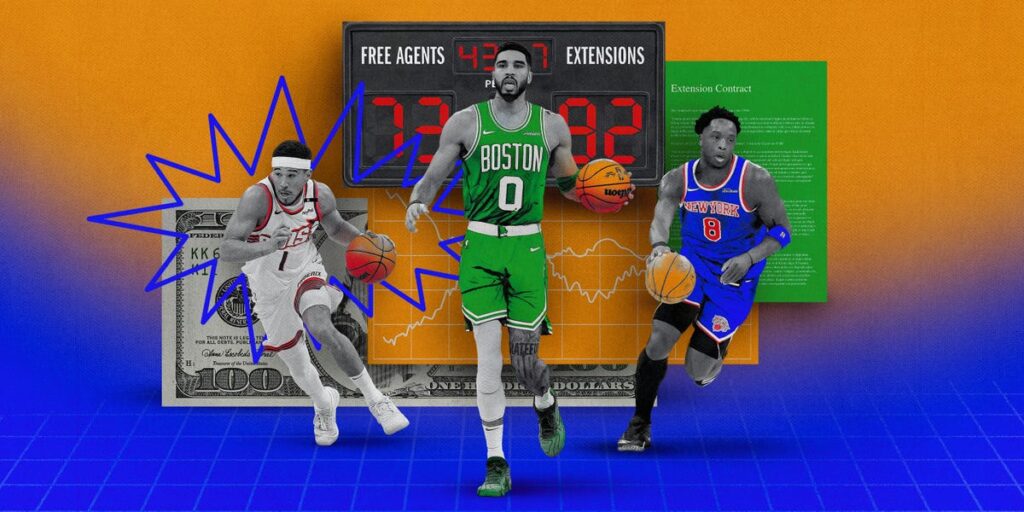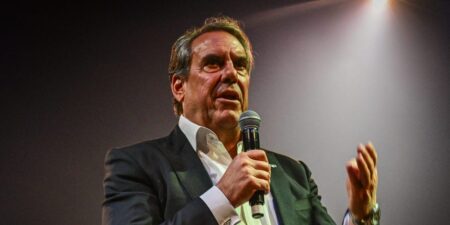This July, the Phoenix Suns made 28-year-old, four-time NBA All-Star Devin Booker an offer he couldn’t refuse: a two-year, $145 million contract extension, even though three years and $171 million still remained on his existing contract.
Booker’s new salary — $72.5 million in annual average income — is the highest in NBA history and keeps him in Phoenix until the summer of 2030, when he’ll be 34. It was a historic commitment, considering that Booker was still three years away from free agency at the time.
Historically, free agency — the period after a player’s team contract ends and they can negotiate to sign with a different team — is typically a chance for athletes to have some control over career factors like location, role, and pay.
Often, players can leverage their way to better pay by joining another team or simply with the threat. Take, for example, New York Knicks forward OG Anunoby, who entered free agency last summer but ultimately signed a five-year, $212 million contract to remain with the Knicks — a year longer and $30 million more than other teams could offer.
However, deals like Booker’s are becoming increasingly common in the league; More NBA players have been forgoing free agency and signing extensions that rank among the heftiest in American sports.
Over the past three years, 17 NBA players signed extensions each worth over $200 million in total value. Others, like Booker, have signed extensions worth less than $200 million in total value, but with average annual salaries topping $40 million. By comparison, the NFL will only have 15 players making $40 million or more for the 2026 season, while MLB will have three.
Why trades are replacing free agency in the NBA
If fewer players are becoming free agents, why are teams offering these mega-extensions?
Bobby Marks, an ESPN NBA salary cap analyst and a former assistant general manager with the Brooklyn Nets, told Business Insider that the NBA incentivized extensions through the players’ union 2023 Collective Bargaining Agreement, which said that teams could offer extensions sooner, and player raises could be higher than in previous CBAs.
As a result, teams’ top players are staying put rather than hitting the open market, eroding a free-agency landscape. Marks wrote for ESPN that between the 2011-12 to 2019-20 seasons, 41 NBA veterans signed contract extensions. Since the 2020-21 season, 104 players have signed extensions.
The players tend to take these deals rather than test the “volatility” of the free-agent market, said Greg Lawrence, an agent for Wasserman who helped Sacramento Kings center Domantas Sabonis secure a four-year, $186 million extension in 2023. Marks agreed.
“I think the lure of guaranteed money is so strong right now,” Marks told Business Insider. “The ability to take something that you know.”
A cycle has resulted: In recent summers, fewer teams have had salary cap space — the amount of available payroll funds before hitting the league-mandated salary cap — stemming in part from COVID-impacted seasons. Less cap space means less cash for potential free-agent contracts, thus creating a push for more contract extensions, which take up teams’ cap space.
According to Lawrence, trades have somewhat replaced free agency. Teams tend to target players through trades instead of signing them outright, and players can secure rich extensions this way. All-Star point guard De’Aaron Fox, for instance, signed a four-year, $222 million extension with the San Antonio Spurs this summer after being traded there earlier in the year. He couldn’t have signed as big a deal with San Antonio this summer as a free agent, according to Marks.
With this trend, NBA fans’ focus has shifted from free-agency speculation to trade speculation, said Lawrence. But that’s not necessarily trouble for the league, as a recent $76 billion TV deal with Disney, Comcast, and Amazon suggests.
How a decrease in free agency could affect the NBA
Critics — like the Golden State Warriors’ Draymond Green and former NBA guard Austin Rivers — have said that the CBA and the lagging free-agent market have squeezed out the NBA’s “middle class.” While many players can get rich extensions, remaining free agents often end up with shorter and smaller contracts.
Meanwhile, extension deals will likely grow, said Marks. The NBA’s new $76 billion TV rights deal will bring the league more revenue, in turn raising the salary cap and with it, player salaries.
Contracts that are worth 25% of today’s salary cap may look like a bargain in two years, when the salary cap is higher. By 2028, it’s possible that a star player could sign a five-year extension with a single-year salary worth over $100 million, Marks said.
Lawrence said he doesn’t think this shift in player transactions has hurt the league, which has historically benefited from viewer attention. While Lawrence acknowledged that the July free-agency periods have been quieter than in years past, he said fan and media hype has turned into a new type of speculation.
“I think it’s almost been replaced by more of a 24/7 news cycle trying to predict, ‘When is this player going to get unhappy?’ and ‘If this team starts the season poorly, is so-and-so going to ask for a trade?'” he said.
Perhaps this year-round speculation could even be better for the league, Lawrence said.
“It just never ends.”
Read the full article here
















